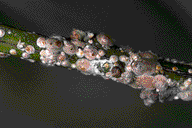Today topic is about the scale, one of common pest for cactus as the blog reader has asked me about how to heal the cactus when scale attacks. Hope it'll be helpful for you guys.
Scale is pinhead-size insects that present themselves as raised tan/brown spots. It is actually hard shell coverings that protect the insect or eggs underneath. Scales reproduce like rabbits, prefer columnar and rock cacti, and dine on plant juices. Infected plants appear yellow and weakened. Left untreated, scale can cause bud and shoot drop. Scale are treated similar to mealy bugs.
Scale and mealy bugs are related insects, and since their life cycles closely parallel each other. In a general scale life cycle, eggs are produced beneath the female shell and hatch into tiny crawlers which are invisible to the unaided eye. Crawlers are not covered by a hard shell and they migrate to newly expanded foliage, finally settling near leaf veins on the underside of leaves or stems. It is this crawler stage, which is practically impossible to detect on cuttings or other propagation material that is responsible for spreading the infestation.
Outbreaks of scale can be triggered by plants being under stress (overwatering/underwatering), too much new growth resulting from an overabundance of nutrients (overfertilizing), overcrowding (unavoidable in some collections) and other conditions specific to the infestation. These other conditions can include injudicious spraying that kills the predators but leaves the scale eggs alive, introduction of a new, more favorable host plant, etc.
Many remedies are available for control depending on how much the scale outbreak.
1. At the beginning, you may choose organic controls including alcohol spray (isopropyl alcohol, straight or diluted), soapy emulsion (can be mixed w/alcohol), horticultural oil (read the directions, taking the plant out of the sun is a must) and pyrethrum spray.
Soapy water/alcohol should be reapplied every 2-3 days for 2 weeks. This is because little residual action can be expected, and newly hatched insects are occurring.
Soapy water/alcohol should be reapplied every 2-3 days for 2 weeks. This is because little residual action can be expected, and newly hatched insects are occurring.
Alcohol in large quantities in the root zone is generally to be avoided since it can dehydrate some tissues. Soapy water/alcohol mix should not be allowed to dry in the root zone since damage can occur. If it is used, after a short period it can be flushed by pouring clean water through the root zone.
2. The most common and easy choice to remove scale is Chemical spray with proven results include Sevin and malathion. DO NOT use sprays containing malathion on the Crassulaceae family of plants. These plants include the common Jade plants. Some species in these genera are very sensitive to Malathion, and damage or death may result. For your safe health, follow the pesticide instruction strictly when you use Malathion.
3. Sometimes, spraying contact pesticides on scale is not effective since their protective hard shell coverings shed water like a well-made roof and the chemical ends up killing the natural predators (lacewings and their larvae that generally keep the scale under control in garden).
Systemic pesticides can work but we should get rid of the alive scales, too. They can't move, so once they are detached from the plant they will die. So you should scrape off the cactus scale by washing the plant with a weak detergent solution or by mechanically removing insects with a toothpick. Then spray Malathion to control major infestations weekly. When fighting scale, be sure to cover the soil, otherwise, these pests will just drop off and then get right back on the plant.
Systemic pesticides can work but we should get rid of the alive scales, too. They can't move, so once they are detached from the plant they will die. So you should scrape off the cactus scale by washing the plant with a weak detergent solution or by mechanically removing insects with a toothpick. Then spray Malathion to control major infestations weekly. When fighting scale, be sure to cover the soil, otherwise, these pests will just drop off and then get right back on the plant.
Information & Photo Source: http://www.cactusmuseum.com/, http://www.oldandsold.com, http://bugyou.blogspot.com/


3 comments:
Good Article
Great post! ;)
This is wonderful blog. I love it.
Post a Comment